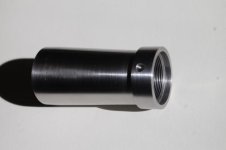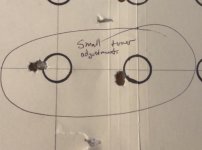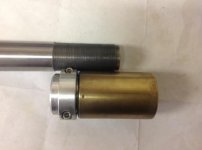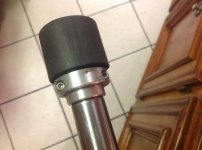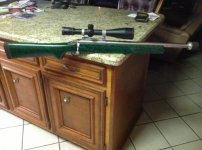I think I was either unclear or you misread what I said. What I meant to say is that tuner adjustments are generally TINY! It's truly amazing how small of an adjustment needs to be made to obviously affect tune. I wish we could get to the point where we talk in terms of barrel stiffness when we discuss tuners. It's really the only way to compare notes. Not only that, but further confusing matters is all of the different tuner designs, weights, and thread pitches. If everyone used my tuner

, and the same length and contour barrels..it'd be much less confusing, as there'd be fewer variables in describing how to adjust them. FWIW, Dan Lilja has a barrel stiffness calculator on his site. It simply gives a relative number for stiffness based on barrel length and contour. It uses other factors as well that make it pretty precise, but I hope we all get the point. There's simply no way that a 4oz. tuner on a 20" hv contour barrel will act exactly like a 8oz tuner on a 24" lv..or similar..so it'd be nice, IMHO, if we could begin using a relative stiffness number, for starters.
Then, we also have factors like tuner weight, that I already mentioned, and location..behind or in front of the muzzle, and how far either way. As you can imagine, it's really just simple leverage, so I think everyone can understand why it matters.
Amazingly enough, even though there are these important factors, we still have a pretty forgiving tool with tuners, in this regard. There seems to be a pretty wide window of weights and locations that actually DO work well on a pretty wide range of barrel stiffness numbers. But, they don't correspond to instructing their use the same with all of the variables. So, the only way to know for sure that you're not skipping over a sweet spot on the tuner, is to move it in very small increments and to be very methodical..and keep good notes while doing it.
IME with most of the commercially available tuners on the market, I recommend .001" liner travel as a good rule of thumb when testing. You can quickly determine what effect it makes, or doesn't make, given your individual rifle and tuner. This is particularly true if you have a known good rifle and load combination to test while establishing how much movement you need to work with between groups fired.
My process is so simple and effective that I can have virtually anyone "trained" on using a tuner in a matter of minutes if they already have a known good rifle and load to begin with.
What I start out looking for is the range of tuner adjustment needed to take the rifle completely in and out of tune. For the sake of this discussion, that's all you need to know about them. I start by shooting 2 or 3 shot groups in good conditions, at 1 mark intervals. On my tuner, 1 mark is equal to .001" of linear travel. So, if you start on zero and go to the number 2, you moved the tuner .002". Simple..right?
I simply fire my 2-3 shot groups at each mark. You can continue doing this for as long as you want..or until the barrel is done..but there is typically no need in firing all of those rounds. As mentioned earlier by I think Sharrett, there will be multiple sweet spots in every single revolution of the tuner. IME, there's no need to try and find which is best, if one is even better than another, I can't shoot well enough to tell it with my br rifles...or anyone else's that I've ever shot, for that matter. Whatever difference there may or may not be between sweet spots is way, way , way smaller than all of the other variables that we deal with..with or without a tuner. In other words, if there's a difference, it gets lost in the noise.
As was said already, there will be multiple sweet spots...like 2-4 of them in a single revolution. Lets think about that for a minute...Since the tune repeats over and over again, AND because it simply goes in and out of tune gradually in either direction that you turn the tuner, there's a predictability here. My tuners have 32 marks on them. Lets say that moving my tuner from 0 to 4 takes it from shooting its best to its worst. That also means that it'll do the same thing if I move it from 0 to 28..best to worst in both directions. Stay with me on this, please. Since there are 8 marks between worst to worst, there are also 8 marks from best to best..in terms of sweet spot or completely out of tune. Now, as I said, my tuner has 32 marks on it. So...theoretically you can turn it a 1/4 turn and be at another sweet spot!! That's assuming something..that the tuner's affect is linear throughout its travel..which it is not, but it is close. So it'll change a bit with travel..i.e. a turn or multiple turns in either direction...just not by a whole lot. But it is enough that you likely will not be in perfect tune by simply moving it in 1/4 turn increments, at all.
But this does explain why some people swear by moving the tuner in larger increments than what I recommend, though..at least to a large degree....because they got LUCKY! I have sold hundreds of my tuners now, to both rimfire and centerfire shooters, as well as even some air rifles shooters. It doesn't matter what's being fired from it, it's still a cantilevered beam and it will vibrate similarly. I have sold several to shooters who called me up or posted on forums to tell me what a great job I did in having it set at it's best setting when I shipped it!!! Of course I just grin and say thank you, but I didn't do anything special to predict the setting for a gun that I've never seen or shot..It was simply that the tune repeats and I got LUCKY! It happened a lot, actually..but if 4 marks takes it from in perfect tune to completely out, the odds were 1 in 4 that it'd happen, since the tuner also has 32 marks around it.(remember, I said stay with me

)
I agree with you, Mike..there are certainly some shooters that do well by setting the tuner, locking it down, and adjusting powder charge, and do very well like that. It's not how I do it, because I think it's leaving a huge benefit of tuners on the table, That being the ability to tune the rifle at the bench, and even to the point of going pre-loaded to matches! I won't argue with anyone that has good success by that method. I do believe what they are seeing is a real benefit of a tuner. That being a wider tune window before needing to adjust the load..so It's real and that IS a benefit of tuners that makes them very much worthwhile, IMHO, alone.
As I said, that's not my preferred method for using one, but if it ain't broke, don't fix it. Obviously, there are some shooters that do it well. Thing is, many of those same shooters were already very good at keeping up with tune issues, WITHOUT a tuner. Tuners just made their life easier here.
My method is to go pre-loaded and tune, if need be, on the first target. Seldom do I need to tune during the match, but it does happen at times. Basically, WITH MY TUNER, on my rifle, I have learned what it looks like when it goes or just starts to go away on me. This is no different than how I use to adjust powder change or seating depth, and for the same reasons, before I began using tuners. It's no different, just a different method of keeping the gun in tune. Commonly, shooters without tuners need to adjust as the day goes on, or when they travel, or when a big swing in temps/humidity occur. With a tuner, the gun is not impervious to those changes, but it is much less affected due to the wider tune window all properly made and mounted tuners give.
Throughout the day, during a match, if I see the gun going away, my typical tuner adjustment is 1 mark or even less. That little bit can most certainly be seen on the target and fine tuning this way can keep my gun shooting at it's FULL potential. No more need to tune for that 1/2 bullet of vertical to keep it from falling off and shooting a big group. I sometimes do though, if I feel like I'm getting too much drift.
Sorry for such a long post. I hope some of you will appreciate it, though, as it is what I have found with tuners and how/why I am 100% convinced that I'll never shoot one of my guns in competition again, without a tuner.
The main point I had hoped to make before going on and on was in regard to making VERY small adjustments with tuners and being very methodical when starting out. By FAR, the most common mistake I see is people making WAY too big of adjustments with them.--Mike Ezell


